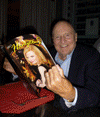Liam Neeson is about to transform himself into a U.S. president. Word has it that in 2007, this 6-foot-4-inch, 53-year-old Irish thespian will star in the title role in Steven Spielberg’s Abraham Lincoln epic, based on Doris Kearns Goodwin’s book, Master Among Men (Simon & Schuster, October 2005). Before our eyes, the “Charming Celtic” with the lyrical brogue will become the taciturn, Illinois-born, 16th President of the United States who guided our nation through the Civil War.
This gifted actor seems to seek out roles that teach a lesson — historical, political, sociological, or humanistic. Among his 56 films, he has played an inordinate number of flawed but crusading figures: German businessman Oskar Schindler (1993, Oscar and Golden Globe nominations), Scottish rebel Rob Roy (1995), Victor Hugo’s Jean Valjean (1998), Irish Republican Army hero Michael Collins (1996, Golden Globe nomination), and 40s sex researcher Alfred Kinsey (2004).
Author Barbara Taylor Bradford told The Sheet that when she first saw Neeson in character, as Blackie O’Neill in the 1983 mini-series A Woman of Substance, based on her novel, she started to cry. It was as if he had walked right out of the pages of her book. “The amazing thing is, he does become the character he’s playing,” she said. “Every time I see Liam Neeson acting, I find that there is, in me, the suspension of disbelief, because Liam makes me believe he is who he is playing.”
"I found out acting could be a form of prayer. It was like a little godsend message."
You don’t have to look far to trace the roots of the messianic zeal that Neeson brings to his roles. Born in predominantly Protestant Ballymena in Northern Ireland, he was christened William John Neeson (and called “Liam” to honor a local priest). For six years, Neeson was an altar boy, a powerful experience he has never forgotten. “The putting on of vestments and lighting candles, it’s a wonderful ritual that never changes from one Mass to another,” the actor told Retta Blaney for her book Working on the Inside: The Spiritual Life through the Eyes of Actors (Rowman & Littlefield, 2003). “It helped fashion me to want to be an actor.”
When her RA was treated with chemotherapy and steroids, the tabloids ran photos of her looking bloated and unsteady, labeling her “a drunk.” Ironically, her eventual attempt to drink away her physical pain actually did lead to alcohol rehab in 2002, where she got her condition and her coping mechanisms under control. Thanks to the new biologic-agent drugs, Turner’s disease has stabilized, but she still lives with chronic pain.
It was a rough-and-tumble start. Nine-year-old Neeson first met success as a boxer at an All Saints youth club, winning a broken nose (his defining facial characteristic). At 13, he claimed the Youth Heavyweight Champion of Ireland title and held it for three years, retiring only after experiencing repeated blackouts and memory loss. At 17, Neeson joined the Slemish Players, a local amateur drama group founded by his childhood English teacher.
The young actor studied math and computer science at the University of Belfast, worked as a truck driver, fork-lift operator, and architect’s assistant, then enrolled in teacher training at Newcastle, where an actors’ training course re-awakened his passion for the dramatic arts.
In 1976, Neeson joined the Lyric Players Theatre in Belfast. Two year later, he moved to the Abbey Theatre, where his 1980 performance in Of Mice and Men led director John Boorman to cast him as Sir Gawain in the film Excalibur.
Neeson’s resume also reveals a wealth of religious roles, beginning with Jesus Christ in John Bunyan’s Pilgrim’s Progress in 1979. To prepare for his 1986 role in The Mission (with Robert De Niro and Jeremy Irons), he read extensively and talked with The Rev. Daniel Berrigan, a technical advisor on the film. Neeson learned that Jesuit founder St. Ignatius Loyola, through his Spiritual Exercises, encouraged students to study Scripture by playing the role of a Biblical character, using all five senses to enter the scene. The actor made the link between this exercise and Stanislavsky’s An Actor Prepares, which details the intense process an actor goes through to prepare for a stage role.
"[Acting] becomes like a mantra. The more you repeat it, the more it reveals its secrets."
“I found out in the jungles of South America that Stanislavsky had based his technique on the Spirtual Exercises,” said Liam. “It brought the two big parts of my life together. The Irish Catholic side was married to the life of an actor and I found out acting could be a form of prayer. It was like a little godsend message.”
Neeson says he often offers his performance “as prayer for someone I’ve worked with as an actor or someone who has died.” The process by which theatre actors enact their parts over and over, daily, further enhances his vision of acting as prayer. “It becomes like a mantra,” Neeson explained. “The more you repeat it, the more it reveals its secrets. You really enter into that world. When you’re doing it eight times a week, you can get in touch with something quite extraordinary.”
Despite his focus on spirituality, as Neeson’s Hollywood star rose, so did rumors of romantic involvements with his co-stars: Helen Mirren (Excalibur, 1981), Cher (Suspect, 1987) and Diane Keaton (The Good Mother, 1988). Alliances with Julia Roberts, Barbra Streisand, Sinéad O’Connor, Jessica Lange, and Brooke Shields were also rumored. Neeson once admitted, “There was a time, when I was 32 or 33, when I liked...getting drunk at night and getting laid as much as I could.”
Then in 1993, he was paired with Natasha Richardson (with whom he’d first acted in the 1984 TV mini-series Ellis Island) in a Broadway revival of Eugene O’Neill’s Anna Christie. Richardson was then newly separated from Robert Fox, who had directed her 1986 London acclaimed performance in The Seagull.
Neeson’s portrayal of the sexually charged seaman Mat Burke in Anna Christie drew Richardson to his raw physicality offstage as well as on (and led to his role in Steven Spielberg’s Schindler’s List). The couple both earned Tony nominations for their steamy performances. Richardson and Fox were divorced a few months later.
The union of the working-class Irish lad and the English upper-class Richardson (daughter of actress Vanessa Redgrave and director Tony Richardson, and granddaughter of Sir Michael Redgrave) was not all smooth sailing. Friends warned her about Neeson’s reputation with his leading ladies. She admitted that that they were like “oil and water together,” and that neither one of them expected to stay together. Still, they got engaged the following year, while filming the Jodie Foster film Nell, and wed in July of 1994. First son, Michael, arrived the next summer, and his brother, Daniel, 14 months later. “My attitude to marriage now is that I have made my choice and I want to stick with that, always,” said Richardson. “I very much hope that I am married to Liam for good and ever.”
And her ex-mate, Fox, certainly hasn’t held a grudge. He co-produced Neeson’s 1998 Broadway run as Oscar Wilde in The Judas Kiss and Richardson’s 1999 appearance in Closer (a Broadway follow-up to her 1998 Tony Award-winning performance in Cabaret).
In 2002, Neeson was recognized with a second Tony nomination for his role in a Broadway revival of The Crucible.
Certainly Neeson’s deep religious beliefs have strengthened him during his survival of two near-death experiences. In 1996, when Daniel was just two days old, Richardson received word that a critically ill Neeson, then at a Venice film festival, had been rushed to a hospital with a blocked intestine. He narrowly escaped death.
Just four years later, the Harley-Davidson-loving actor was riding his bike while on location with Richardson in Canada when he collided with a deer, shattered his pelvis, and suffered multiple injuries. “She was there every minute, holding my hand, which was a wonderful inspiration,” said Neeson of his wife.
Speaking of the episodes, Richardson said, “I wake up every morning feeling lucky, which is driven by fear, no doubt, since I know it could all go away.”
Now fully recovered (after fears he might not walk again), Neeson is no stranger to action films. He followed his 1999 role as a Master Jedi Knight in Star Wars: Episode 1 - The Phantom Menace, with his 2002 role as the boxing Priest Vallone in Martin Scorsese’s film Gangs of New York. In 2002, Neeson also starred opposite Harrison Ford in K-19: The Widow-maker, a based-on-facts thriller about a 1961 Russian nuclear submarine accident. Early this year, he played Godfrey of Ibelin in Ridley Scott’s Kingdom of Heaven. And all summer long, he looms on the big screen in Batman Begins.
Increasingly, this successful actor is channeling his convictions into philanthropic efforts. He hosted the Nobel Peace Prize Concert in 2001, is a UNICEF Ireland Goodwill Ambassador, and only signs autographs to benefit children’s causes.
Neeson hopes to someday star as King Arthur in a Broadway revival of Camelot, with his wife as his Queen Guenevere. That would be pure box-office magic — Richardson’s mother, Vanessa Redgrave, magically filled that role in the 1967 film Camelot.
"There was a time, when I was 32 or 33, when I liked… getting drunk at night and getting laid as much as I could."
Neeson and his family continue to split their time between a NYC apartment and a country home in Millbrook, NY. And faith remains his cornerstone. “I always drop in a church when passing [by] to say my Catholic prayers,” he confessed, “and I make sure my children say them.” The boys are being raised as Catholics because “they should learn some roots in a certain dogma.”
He thanks his lucky stars everyday, “I’m healthy, I have some money in the bank, I have healthy children, and a wonderful wife.”
|




